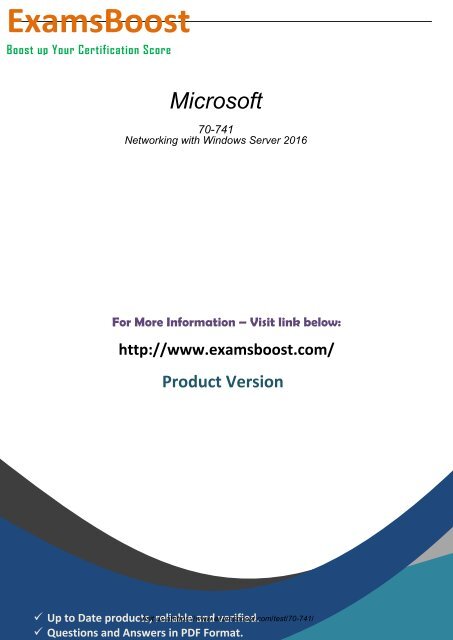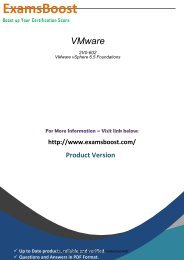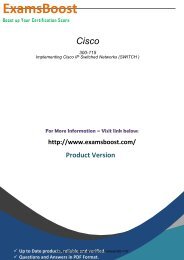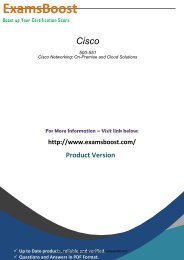70-741 Exams Study Guides 2018
Study kits and preparation materials provided by us for 70-741 Test are authorized by the professionals and industry experts. You can easily pass your certification test with our brain dumps and PDF sample questions. For more info please visit here: http://www.examsboost.com/test/70-741/
Study kits and preparation materials provided by us for 70-741 Test are authorized by the professionals and industry experts. You can easily pass your certification test with our brain dumps and PDF sample questions. For more info please visit here: http://www.examsboost.com/test/70-741/
You also want an ePaper? Increase the reach of your titles
YUMPU automatically turns print PDFs into web optimized ePapers that Google loves.
<strong>Exams</strong>Boost<br />
Boost up Your Certification Score<br />
Microsoft<br />
<strong>70</strong>-<strong>741</strong><br />
Networking with Windows Server 2016<br />
For More Information – Visit link below:<br />
http://www.examsboost.com/<br />
Product Version<br />
Up to Date products, reliable and verified.<br />
Questions and Answers in PDF Format.<br />
Visit us athttps://www.examsboost.com/test/<strong>70</strong>-<strong>741</strong>/
Question: 1<br />
You have a server named Server1 that runs Windows Server 2016.<br />
Server1 has two network cards. One network card connects to your internal network and the other<br />
network card connects to the Internet.<br />
You plan to use Server1 to provide Internet connectivity for client computers on the internal network.<br />
You need to configure Server1 as a network address translation (NAT) server.<br />
Which server role or role service should you install on Server1 first?<br />
A. Network Controller<br />
B. Web Application Proxy<br />
C. Routing<br />
D. DirectAccess and VPN (RAS)<br />
Question: 2<br />
Answer: C<br />
You have multiple servers that run Windows Server 2016 and are configured as VPN servers.<br />
You deploy a server named NPS1 that has Network Policy Server (NPS) installed.<br />
You need to configure NPS1 to accept authentication requests from the VPN servers.<br />
What should you configure on NPS1?<br />
A. From RADIUS Clients and Servers, add a remote RADIUS server group.<br />
B. From Policies, add a connection request policy.<br />
C. From Policies, add a network policy.<br />
D. From RADIUS Clients and Servers, add RADIUS clients.<br />
Question: 3<br />
Answer: D<br />
You are deploying a small network that has 30 client computers. The network uses the 192.168.1.0/24<br />
address space. All computers obtain IP configurations from a DHCP server named Server1.<br />
You install a server named Server2 that runs Windows Server 2016. Server2 has two network adapters<br />
named internal and Internet. Internet connects to an Internet service provider (ISP) and obtains the<br />
131.107.0.10 IP address. Internal connects to the internal network and is configured to use the<br />
192.168.1.250 IP address.<br />
You need to provide Internet connectivity for the client computers.<br />
What should you do?<br />
Visit us athttps://www.examsboost.com/test/<strong>70</strong>-<strong>741</strong>/
A. On Server2, select the Internet and Internal network adapters and bridge the connections. From the<br />
DHCP console on Server1, authorize Server2.<br />
B. On Server1, stop the DHCP server. On the Internal network adapter on Server 2, enable Internet<br />
Connection Sharing (ICS).<br />
C. On Server2 run the New-NetNat –Name NAT1 -InternalIPInterfaceAddressPrefix 192.168.1.0/24<br />
cmdlet. Configure Server1 to provide the 003 Router option of 131.107.0.10.<br />
D. Install the Routing role service on Server2 and configure the NAT routing protocol. Configure Server1<br />
to provide the 003 Router option of 192.168.1.250.<br />
Question: 4<br />
Answer: B<br />
You are implementing a new network. The network contains a DHCP server named DHCP1 that runs<br />
Windows Server 2016. DHCP1 contains a scope named Scope1 for the 192.168.0/24 subnet.<br />
Your company has the following policy for allocating IP addresses:<br />
All server addresses must be excluded from DHCP scopes.<br />
All client computer must receive IP addresses from Scope1.<br />
All Windows servers must have IP addresses in the range of 192.168.0.200 to 192.168.0.240<br />
All other network devices must have IP addresses in the range of 192.168.0.180 to 192.168.0.199.<br />
You deploy a print device named Print1.<br />
You need to ensure that Print1 adheres to the policy for allocating IP addresses.<br />
Which command should you use?<br />
A. Add-DhcpServerv4Lease<br />
B. Add-DhcpServerv4ExclusionRange<br />
C. Add-DhcpServerv4Filter<br />
D. Add-DhcpServerv4Reservation<br />
Question: 5<br />
Answer: B<br />
You have a DHCP server named Server1 that runs Windows Server 2016.<br />
You have a single IP subnet.<br />
Server1 has an IPv4 scope named Scope1. Scope1 has an IP address range of 10.0.1.10 to 10.0.1.200 and<br />
a length of 24 bits.<br />
You need to create a second logical IP network on the subnet. The subnet will use an IP address range of<br />
10.0.2.10 to 10.0.2.200 and a length of 24 bits.<br />
What should you do?<br />
A. Create a second scope, and then create a superscope.<br />
B. Create a superscope, and then configure an exclusion range in Scope1.<br />
C. Create a new scope, and then modify the IPv4 bindings.<br />
Visit us athttps://www.examsboost.com/test/<strong>70</strong>-<strong>741</strong>/
D. Create a second scope, and then run the DHCP Split-Scope Configuration Wizard.<br />
Question: 6<br />
Answer: A<br />
HOTSPOT<br />
Your network contains an Active Directory domain named contoso.com. The domain contains a domainbased<br />
Distributed File System (DFS) namespace named Namespace1.<br />
You need to view the shares to which users will be redirected when the users attempt to connect to a<br />
folder named Folder1 in the DFS namespace.<br />
What cmdlet should you run? To answer, select the appropriate options in the answer area.<br />
Answer:<br />
Question: 7<br />
Note: This question is part of a series of questions that present the same scenario. Each question in the<br />
series contains a unique solution. Determine whether the solution meets the stated goals.<br />
Your network contains an Active Directory domain named contoso.com. The domain contains a DNS<br />
server named Server1. All client computers run Windows 10.<br />
On Server1, you have the following zone configuration.<br />
Visit us athttps://www.examsboost.com/test/<strong>70</strong>-<strong>741</strong>/
You need to ensure that all of the client computers in the domain perform DNSSEC validation for the<br />
fabrikam.com namespace.<br />
Solution: From a Group Policy object (GPO) in the domain, you add a rule to the Name Resolution Policy<br />
Table (NRPT).<br />
Does this meet the goal?<br />
A. Yes<br />
B. No<br />
Answer: A<br />
Explanation:<br />
The NRPT stores configurations and settings that are used to deploy DNS Security Extensions (DNSSEC),<br />
and also stores information related to DirectAccess, a remote access technology.<br />
Note: The Name Resolution Policy Table (NRPT) is a new feature available in Windows Server 2008 R2.<br />
The NRPT is a table that contains rules you can configure to specify DNS settings or special behavior for<br />
names or namespaces. When performing DNS name resolution, the DNS Client service checks the NRPT<br />
before sending a DNS query. If a DNS query or response matches an entry in the NRPT, it is handled<br />
according to settings in the policy. Queries and responses that do not match an NRPT entry are<br />
processed normally.<br />
References: https://technet.microsoft.com/en-us/library/ee649207(v=ws.10).aspx<br />
Question: 8<br />
Note: This question is part of a series of questions that present the same scenario. Each question in the<br />
series contains a unique solution. Determine whether the solution meets the stated goals.<br />
Your network contains an Active Directory domain named contoso.com. The domain contains a DNS<br />
server named Server1. All client computers run Windows 10.<br />
On Server1, you have the following zone configuration.<br />
You need to ensure that all of the client computers in the domain perform DNSSEC validation for the<br />
fabrikam.com namespace.<br />
Solution: From a Group Policy object (GPO) in the domain, you modify the Network List Manager<br />
Policies.<br />
Does this meet the goal?<br />
Visit us athttps://www.examsboost.com/test/<strong>70</strong>-<strong>741</strong>/
A. Yes<br />
B. No<br />
Answer: B<br />
Explanation:<br />
Network List Manager Policies are security settings that you can use to configure different aspects of<br />
how networks are listed and displayed on one computer or on many computers.<br />
Network List Manager Policies are not related to DNSSEC.<br />
References: https://technet.microsoft.com/en-us/library/jj966256(v=ws.11).aspx<br />
Question: 9<br />
Note: This question is part of a series of questions that present the same scenario. Each question in the<br />
series contains a unique solution that might meet the stated goals. Some question sets might have more<br />
than one correct solution, while others might not have a correct solution.<br />
After you answer a question in this sections, you will NOT be able to return to it. As a result, these<br />
questions will not appear in the review screen.<br />
You network contains an Active Directory domain named contoso.com. The domain contains a member<br />
server named Server1 that runs Windows Server 2016 and has the DNS Server role installed. Automatic<br />
scavenging of state records is enabled and the scavenging period is set to 10 days.<br />
All client computers dynamically register their names in the contoso.com DNS zone on Server1.<br />
You discover that the names of multiple client computers that were removed from the network several<br />
weeks ago can still be resolved.<br />
You need to configure Server1 to automatically remove the records of the client computers that have<br />
been offline for more than 10 days.<br />
Solution: You set the Expires after value of the zone.<br />
Does this meet the goal?<br />
A. Yes<br />
B. No<br />
Explanation:<br />
https://technet.microsoft.com/en-us/library/cc772069(v=ws.11).aspx<br />
Question: 10<br />
Answer: B<br />
Note: This question is part of a series of questions that present the same scenario. Each question in the<br />
series contains a unique solution. Determine whether the solution meets the stated goals.<br />
Your network contains an Active Directory domain named contoso.com. The domain contains a DNS<br />
server named Server1. All client computers run Windows 10.<br />
On Server1, you have the following zone configuration.<br />
Visit us athttps://www.examsboost.com/test/<strong>70</strong>-<strong>741</strong>/
You have the following subnets defined on Server1.<br />
You need to prevent Server1 from resolving queries from DNS clients located on Subnet4. Server1 must<br />
resolve queries from all other DNS clients.<br />
Solution: From the Security Setting of each zone on Server1, you modify the permissions.<br />
Does this meet the goal?<br />
A. Yes<br />
B. No<br />
Question: 11<br />
Answer: B<br />
Note: This question is part of a series of questions that present the same scenario. Each question in the<br />
series contains a unique solution. Determine whether the solution meets the stated goals.<br />
Refer to exhibit:<br />
Server1 has two virtual machines named VM1 and VM that run Windows Server 2016. VM1 connects to<br />
Private VM2 has two network adapters.<br />
You need to ensure that VM1 connects to the corporate network by using NAT.<br />
Solution: You connect VM2 to private1 and External1. You run the New-NetNatIpAddress and the New-<br />
NetNat cmdlets on VM2. You configure VM1 to use VM2 as the default gateway.<br />
Does this meet the goal?<br />
A. Yes<br />
Visit us athttps://www.examsboost.com/test/<strong>70</strong>-<strong>741</strong>/
B. No<br />
Answer: B<br />
Question: 12<br />
Note: This question is part of a series of questions that present the same scenario. Each question in the<br />
series contains a unique solution. Determine whether the solution meets the stated goals.<br />
Refer to exhibit:<br />
Server1 has two virtual machines named VM1 and VM that run Windows Server 2016. VM1 connects to<br />
Private VM2 has two network adapters.<br />
You need to ensure that VM1 connects to the corporate network by using NAT.<br />
Solution: You connect VM1 to Internal1. You run the New-NetNatIpAddress and the New-NetNat<br />
cmdlets on Server1. You configure VM1 to use VM2 as the default gateway.<br />
Does this meet the goal?<br />
A. Yes<br />
B. No<br />
Question: 13<br />
Answer: A<br />
Note: This question is part of a series of questions that present the same scenario. Each question in the<br />
series contains a unique solution. Determine whether the solution meets the stated goals.<br />
Refer to exhibit:<br />
Server1 has two virtual machines named VM1 and VM that run Windows Server 2016. VM1 connects to<br />
Private VM2 has two network adapters.<br />
You need to ensure that VM1 connects to the corporate network by using NAT.<br />
Visit us athttps://www.examsboost.com/test/<strong>70</strong>-<strong>741</strong>/
Solution: You connect VM2 to private1 and External1. You install the Remote Access Serverrole on VM2,<br />
and you configure NAT in the Routing and Remote Access console. You configure VM1 to use VM2 as the<br />
default gateway.<br />
Does this meet the goal?<br />
A. Yes<br />
B. No<br />
Question: 14<br />
Answer: A<br />
HOTSPOT<br />
You have a DNS server named Server1 that runs Windows Server 2016. Server1 has network interfaces<br />
that have the following IP addresses:<br />
-10.0.0.100<br />
-131.107.0.100<br />
The internal network uses an IP address space of 10.0.0.0/16.<br />
Server1 provides DNS name resolution to both internal and external clients. Server1 hosts the primary<br />
zone for contoso.com.<br />
You need to configure Server1 to meet the following requirements:<br />
* Internal clients must be able to use Server 1 to resolve internal-based DNS names.<br />
* External clients must not be able to use Server1 to resolve Internal-based DNS names.<br />
* External clients must able to use Server1 to resolve names in the contoso.com zone.<br />
Which commands should you run on Server1.? To answer select the appropriate option in answer area.<br />
Visit us athttps://www.examsboost.com/test/<strong>70</strong>-<strong>741</strong>/
Visit us athttps://www.examsboost.com/test/<strong>70</strong>-<strong>741</strong>/<br />
Answer:
Question: 15<br />
You have an IP Address Management (IPAM) server named IPAM1 that runs Windows Server 2016.<br />
IPAM1 manages 10 DHCP servers.<br />
You need to provide a user with the ability to track which clients receive which IP addresses from DHCP.<br />
The solution must minimize administrative privileges.<br />
A. IPAM MSM Administrators<br />
B. IPAM ASM Administrators<br />
C. IPAM IP Audit Administrators<br />
D. IPAM User<br />
References: https://technet.microsoft.com/en-us/library/jj878348(v=ws.11).aspx<br />
Question: 16<br />
Answer: C<br />
You have an IP Address Management (IPAM) deployment that is used to manage all of the DNS servers<br />
on your network. IPAM is configured to use Group Policy provisioning.<br />
Visit us athttps://www.examsboost.com/test/<strong>70</strong>-<strong>741</strong>/
You discover that a user adds a new mail exchanger (MX) record to one of the DNS zones.<br />
You want to identify which user added the record.<br />
You open Event Catalog on an IPAM server, and you discover that the most recent event occurred<br />
yesterday. You need to ensure that the operational events in the event catalog are never older than one<br />
hour.<br />
What should you do?<br />
A. From the properties on the DNS zone, modify the refresh interval.<br />
B. From an IPAM_DNS Group Policy object (GPO), modify the Group Policy refresh interval.<br />
C. From Task Scheduler, modify the Microsoft\Windows\IPAM\Audit task.<br />
D. From Task Scheduler, create a scheduled task that runs the Update-IpamServer cmdlet.<br />
Question: 17<br />
Answer: C<br />
HOTSPOT<br />
Your company has a branch office that has three floors. The office currently uses a different subnet on<br />
each floor. The subnets are configured as shown in the following table.<br />
You have been asked to use reconfigure the network to use one subnet that encompasses all three<br />
floors. The new subnet will come from the 192.168.0.0/16 address space.<br />
You need to identify which IP address and which subnet mask to use for the default gateway. The<br />
solution must meet the following requirements:<br />
• Use the first available subnet<br />
• Use a single subnet for all three floors.<br />
• Use the first available IP address on the segment for the default gateway.<br />
• Minimize the number of unused IP addresses.<br />
Which IP address and which subnet mask should you identify? To answer, select the appropriate options<br />
in the answer area.<br />
Visit us athttps://www.examsboost.com/test/<strong>70</strong>-<strong>741</strong>/
Answer:<br />
255.255.255.0<br />
192.168.0.64<br />
Question: 18<br />
Your company has five departments, including a web research department.<br />
You have a DHCP server named Server1 and two DNS servers named DNS1 and DNS2.<br />
Server1 has an IPv4 scope named Scope1. All client computers are configured to use DNS1 for name<br />
resolution.<br />
You need to ensure that users in the web research department use DNS2 for name resolution.<br />
A. From the properties of Scope1, modify the Conflict detection attempts setting.<br />
B. From the properties of Scope1, configure Name Protection.<br />
C. From the properties of IPv4, configure the bindings.<br />
D. From IPv4, create a new filter.<br />
E. From the properties of Scope1, create an exclusion range.<br />
F. From IPv4, run the DHCP Policy Configuration Wizard.<br />
G. From Control Panel, modify the properties of Ethernet<br />
H. From Scope1 create a reservation.<br />
Question: 19<br />
Answer: A<br />
You have a server named Server1 that runs Windows Server 2016.<br />
Server1 will be used as a VPN server.<br />
You need to configure Server1 to support VPN Reconnect.<br />
Visit us athttps://www.examsboost.com/test/<strong>70</strong>-<strong>741</strong>/
Which VPN protocol should you use?<br />
A. IKEv2<br />
B. L2TP<br />
C. PPTP<br />
D. SSTP<br />
Answer: A<br />
Visit us athttps://www.examsboost.com/test/<strong>70</strong>-<strong>741</strong>/
Powered by TCPDF (www.tcpdf.org)<br />
Thank You for Trying Our Product<br />
For More Information – Visit link below:<br />
http://www.examsboost.com/<br />
FEATURES<br />
90 Days Free Updates<br />
Money Back Pass Guarantee<br />
Instant Download or Email Attachment<br />
24/7 Live Chat Support<br />
PDF file could be used at any Platform<br />
50,000 Happy Customer<br />
Visit us athttps://www.examsboost.com/test/<strong>70</strong>-<strong>741</strong>/










![Cisco 300-075 [2018] Updated 300-075 Dumps PDF by ExamsBoost](https://img.yumpu.com/59900470/1/184x260/cisco-300-075-2018-updated-300-075-dumps-pdf-by-examsboost.jpg?quality=85)





